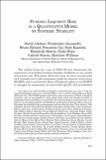Artículo
Funding liquidity risk in a quantitative model of systemic stability
Fecha
2010Resumen
The global financial crisis of 2007–09 has illustrated the importance of including funding liquidity feedbacks in any model of systemic risk. This paper illustrates how we have incorporated such channels into a risk assessment model for systemic institutions (RAMSI) and it outlines the Bank of England’s plans to use RAMSI to sharpen its assessment of institution-specific and systemwide vulnerabilities. The model focuses on the health of core banks in the U.K. financial system. For these banks the model provides a coherent quantitative framework for assessing how shocks transmit through balance sheets allowing for macro-credit risk interest and noninterest income risk network interactions and feedback effects arising on both the asset and liability side of the balance sheet. Systemic risks stem from the connectivity of bank balance sheets via interbank exposures (counterparty risk) the interaction between balance sheets and asset prices (fire-sale effects) and confidence effects that may affect funding conditions.
Colecciones
Descargar


